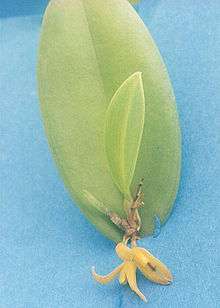Pleurothallis
Pleurothallis, abbreviated Pths in horticultural trade, is a genus of orchids commonly named bonnet orchids. The genus name is derived from the Greek word 'pleurothallos', meaning 'riblike branches'. This refers to the rib-like stems of many species.
| Bonnet orchids | |
|---|---|
 | |
| Scientific classification | |
| Kingdom: | Plantae |
| Clade: | Tracheophytes |
| Clade: | Angiosperms |
| Clade: | Monocots |
| Order: | Asparagales |
| Family: | Orchidaceae |
| Subfamily: | Epidendroideae |
| Subtribe: | Pleurothallidinae |
| Genus: | Pleurothallis R.Br., 1813 |
| Species | |
|
| |
| Synonyms[1] | |
| |
This was a huge genus, which used to contain more than 1,200 species - the second largest in the Orchidaceae after Bulbophyllum. In 2004, it decreased by more than half when many species were moved into new genera.[2]
Distribution
Pleurothallis is a completely New World group, widespread across much of Mexico, Central America, South America and the West Indies.[1] Flora of North America[3] lists one species in Florida (P. gelina) but this has now been transferred to a different genus, Stelis.[4] The center of diversity of the genus is in the high Andes, especially in the chain of cloud forests in Colombia. Pleurothallis grows in dry or wet, tropical or temperate climates.
Morphology
As a group they show a huge range in vegetative form, terrestrial or epiphytic, and can be found as tall cane-like plants a metre or so high, clumped or trailing, pendent or climbing, erect or creeping, tufted and tiny, delicate moss-like species that can grow on the thinnest of twigs. But they have one common denominator: they all have two pollinia.
They have reduced their pseudobulbs and instead, some species have thick succulent leaves.
Their flowers are among the most diverse and unusual, although often very small, and specialize in using tiny insects such as gnats or Chalcid wasps for pollination.
Taxonomy
To bring some order in this extremely diverse genus, 29 subgenera and 25 sections had been created. Much of this work has been done by Dr. C. Luer of MOBOT. A new analysis, based on DNA testing, has confirmed on the whole the classification of the subtribe Pleurothallidinae, with however Pleurothallis as the main difference. This should not surprise anyone, since this somewhat artificial genus has been the dumping ground for species that did not fit into any other genus. New genetic insight has broken up this huge genus and made it more consistent with the principles of monophyletic genera and evolutionary relationships.
Several times before, a splitting up has been attempted, but there were always too many intermediate forms. In 2004 the new genera Acianthera, Ancipitia, Antilla, Apoda-prorepentia, Areldia, Atopoglossum, Brenesia, Crocodeilanthe were created, incorporating a large number of former Pleurothallis species (Monogr. Syst. Bot. Missouri Bot. Gard. 95: 255. 2004 [Feb 2004]). The subgenera Pleurothallis and Specklinia are becoming separate genera, and the subgenus Acuminatae might become the proposed genus Anathallis.
Other allied genera include: Dracula, Masdevallia, Restrepia and Stelis.[5]
Species
This is a long list, with about 1240 species. See List of Pleurothallis species.
A few have common names :
- Pleurothallis angustifolia : Wilson's Bonnet Orchid
- Pleurothallis appendiculata : Hand Bonnet Orchid (now a synonym of Antilla appendiculata (Cogn.) Luer in 2004)
- Pleurothallis aristata : Forest Bonnet Orchid
- Pleurothallis domingensis : Guadeloupe Bonnet Orchid (now a synonym of Crocodeilanthe domingensis (Cogn.) Luer 2004)
- Pleurothallis immersa : Black Orchid - now a synonym of Specklinia immersa (Linden & Rchb.f.) Luer
- Pleurothallis nipterophylla : Cupped Leaf Orchid
- Pleurothallis oblongifolia : Ladies' Bonnet Orchid
- Pleurothallis obovata : South American Bonnet Orchid - now a synonym of Anathallis obovata
- Pleurothallis pruinosa : Waxy Bonnet Orchid
- Pleurothallis pubescens : Hairy Bonnet Orchid
- Pleurothallis ruscifolia : Green Bonnet Orchid
- Pleurothallis scurrula : Little Clown Orchid
- Pleurothallis segoviensis : Trout-fly Orchid - now synonym of Unciferia segoviensis (Rchb.f.) Luer
- Pleurothallis sieberi: Luer
References
- Kew World Checklist of Selected Plant Families, Pleurothallis
- (Monogr. Syst. Bot. Missouri Bot. Gard. 95: 256. Feb 2004).
- Flora of North America v 26 p 617, Pleurothallis gelida
- Kew World Checklist of Selected Plant Families, Pleurothallis gelida
- Analysis of the DNA-Based Reclassification of the Pleurothallidinae
- Luer, Carlyle; 1986 - Icones Pleurothallidinarum III: Systematics of Pleurothallis (Orchidaceae); Missouri Botanical Garden Press.
- Pridgeon, A. & M. Chase (2001). "A phylogenetic reclassification of Pleurothallidinae (Orchidaceae)". Lindleyana. 16: 235–271.
External links


- Analysis of the DNA-Based Reclassification of the Pleurothallidinae
- Orchids of the Pleurothallid Alliance
- Photos